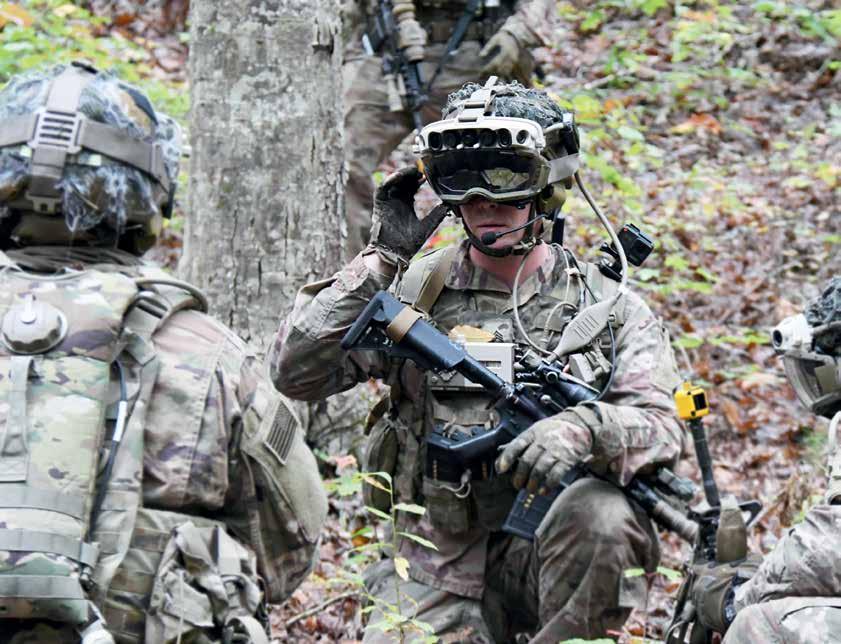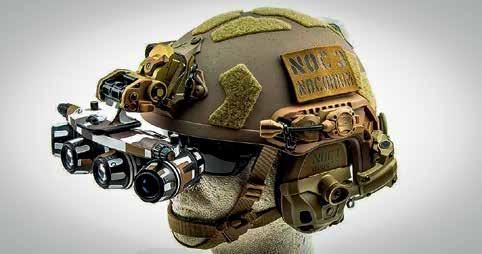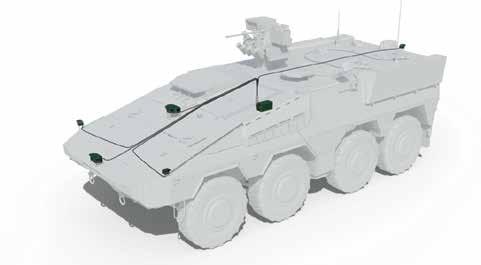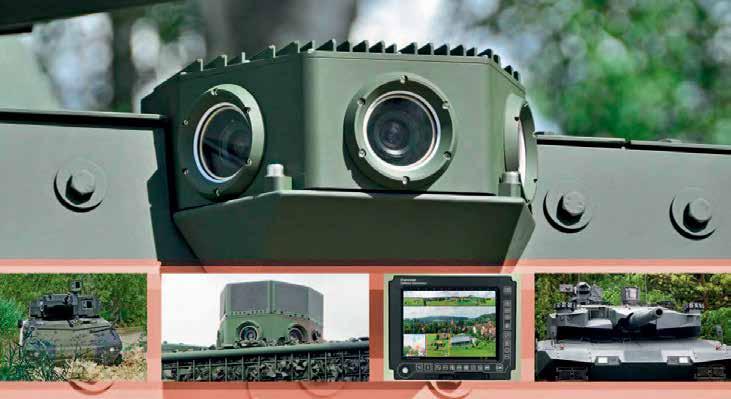
3 minute read
LOOKING BEYOND THE MARK ONE EYEBALL
The need for soldiers to know their immediate surroundings is essential to both their combat effectiveness and survival.
Basic ‘situational awareness’ on the battlefield comes down to the reliance on, predominantly, an individual soldier’s visual senses. The development of Image Intensification (I2) which uses a photocathode plate that ‘gathers ambient light’ which is then electronically displayed on a phosphor screen in a wavelength visible to the human eye has proved to be a game-changer.
Advertisement
The image is typically yellow-green (using a P-43 screen) or white (with a P-45 screen) although other colours including red are possible. A key advantage is that it is passive emitting no signature itself. Currently, the Generation (Gen) III I2 using gallium arsenide photocathode tubes offer the highest clarity and performance. Gen IV includes ‘gated’ technology that adjusts more quickly to changes in the surrounding light levels. With Gen III not only has the price of I2 has been lowered but both weight and size have been significantly reduced. As an example, the 1996 AN/PVS-2 Starlight Scope weighed 7.5 pounds (3.4 kilogrammes) and was 17.5 inches (700 millimetres) long while today’s equivalent the PVS-14 is only 12.5 ounces (0.35kg ) and 4.5in (114mm).
These factors have seen I2 widely fielded with palm-size hand-held surveillance and weapon mounted sighting versions, head or helmet mounted monocular and binocular goggles. I2 is ideally suited to meeting stand-alone night situational awareness needs of air crews, infantry, and general use. Its reliance on ambient light has become of less of a concern in newer systems with greater sensitivity performing at much reduced light levels. Like human vision, it is hindered by smoke, fog and other obscurants. As in any sight the field of view is narrowed reducing the wearer’s perception and peripheral vision. This can be a particular concern with a head or helmet goggle necessitating constantly turning the head to view a full scene. The introduction of panoramic (also called ‘Quad’) night vision goggles with four image tubes begin to address this expanding the field-of-view (FOV) to 97 degrees in the L3Harris and EOTech models and 104 degrees in Photonis Defense’s version.
Low Light Level Tv
I2 tubes display the resulting image directly to the viewer and does not emit an electronic or digital signal. Although ideal for stand-alone applications, it is difficult to incorporate the imagery into a broader situational awareness system. In such applications, Low Light Level TV (LLTV) is often preferred. LLLTV is a CCD camera sensitive in the 0.4 to 0.7 and 1.0 to 1.1 short-wave infra-red micrometre wave lengths which are outside human normal ‘visible’ viewing. It detects objects in extremely low light levels but shows the resulting electronic digital signals. This digital data can then be converted for display, processed, and/or integrated with other sensor information. Typically, LLLTV have been monochrome
Image intensification (I2) is the most widely used night vision augmentation, with the latest being lightweight and compact allowing their adaption for individual use including weapon sights and helmet mounted goggles. Being passive, they offer discrete night viewing. The Panoramic night vision goggle (EO TECH Quad) provides a wider up to 107 degree field of view.

(black & white). However, the firm SPi’s x27 LLLTV provides high-definition full-colour digital images approaching daylight quality even at low light levels of one millilux! The SIOYX ultra-low colour light camera is used in the US Army IVAS (discussed later). A digital signal from x27 and other LLLTV cameras can be incorporated with other digital imager information including thermal imaging cameras, offering a more comprehensive picture. These cameras can be compact permitting them to be more easily be positioned all-around a vehicle, for example, thereby providing 360-degree surveillance as is the case in Rheinmetall’s SAS - Situational Awareness System.



Thermal Imaging
Where I2 relies on of ambient light, thermal imaging detects the temperature differences of objects. The performance of the thermal imager is a function of the sensitivity of its detectors to these temperature differences, referred to as T (Delta T), with sensitivity levels of 0.2 degrees C (0.4F) and better are possible. Thermal imaging does not rely on any outside illumination so it is effective even in a tunnel or building and can view through smoke, fog and vegetation. It is particularly effective in detecting objects with ‘hot’ signatures including vehicles, humans and animals. Displays can be programmed to assign colours to various temperature differences or in monochrome scenes to ‘reverse polarity’ with either white or black showing the hottest objects.
A drawback of thermal imaging has been its lower resolution and lack of finer image details. This can make it difficult for users to identify the specifics of what they are observing. Even at relatively close range, though it might be evident one was viewing a tank for example, the type or if was friend or enemy was not so obvious. The danger was the possibility of firing on friendly forces – something that unfortunately occurred a number of times during battles in Iraq in 2003 which saw the first widescale use of thermal sights on combat vehicles. The developments in two-dimensional Focal Plane Arrays increased the number of pixels giving a higher resolution to address this. For example, a 160x120 array with 19,600 pixels has low resolution, while a 320x240







